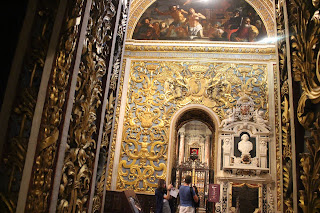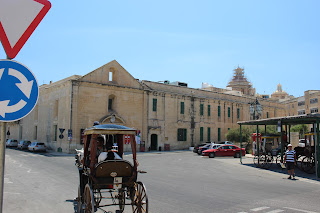On Thursday, June 22nd, we breakfasted on some of the fruit, bread, jam and coffee supplied gratis in the apartment. Then we went out to see what we could see of the old city of Valletta. Though it is not really so old—Europe’s first modern city to be planned and built from scratch, in the sixteenth century.
We started off by visiting the Upper Barakka Gardens, overlooking the Grand Harbor. Then, we went to the Co-Cathedral of St. John, the principal church of the Order of Knights of the Hospital of Saint John of Jerusalem--the Knights of Malta. Until 1530, Malta was a part of the Kingdom of Sicily. Eight years before, the Ottoman Turks had conquered the Knights’ stronghold, the island of Rhodes, leaving them without a home base. In 1530, Emperor Charles V, who ruled Sicily, gave Malta to the Order for an annual rent of one Maltese falcon (which is the initiating situation for the movie of that name). The Knights, who had become primarily a seafaring force on Rhodes, moved the capital of the island from the ancient, central city of Mdina (the Roman Melita) to Birgu, on the Grand Harbor. In 1565 a Turkish invasion fleet arrived, to put an end to the troublesome Knights once and for all. The Great Siege, though hard-fought, ended with complete defeat for the Ottomans. Six years later, the battle of Lepanto permanently destroyed the Turkish naval threat, leaving the Knights with little to do except battle Barbary corsairs.
But the Knights rebuilt and refortified the Grand Harbor area, creating on a hill on the peninsula between the two harbors their new capital of Valletta, named after the Grand Master La Vallette, who had won the Great Siege. The Knights ran Malta until they were ousted by Napoleon. The French alienated the Maltese by looting their churches (Malta is the most devoutly Catholic country in the EU), and were kicked out with the help of Admiral Lord Nelson and his British fleet. The British made Malta their naval bastion in the central Mediterranean, which led, during World War II, to another great siege: Malta was under severe, prolonged air attack by Italian and German forces for much of the war, suffering many casualties and great damage, but never giving up. Malta gained its independence from Britain (though it’s still a member of the Commonwealth) in the 1970s, and is now a republic, a member of the European Union and on the euro.
The Co-Cathedral (the Cathedral is still in Mdina) started out rather plainly decorated, but over the years Grand Masters and other wealthy Knights, who, generally, had to be of pure noble birth, poured large sums into making the church a baroque fantasia.
In the church’s Oratory we met up again with Caravaggio. The painter was not at all a starving artist, unappreciated by his contemporaries. They were well aware of his genius, which enabled this quarrelsome, violent man to, quite literally, get away with murder. Caravaggio spent most of his career in Rome, but in 1608 he killed a man there, and had to go on the run until things cooled down and he could get a papal pardon. The Knights’ Grand Master at that time saw an opportunity, and welcomed Caravaggio to Malta, getting him into the Order and putting him to work. Two of the results are in this church: the “St. Jerome” and the “Beheading of John the Baptist,” the painter’s largest work and the only one that he signed. By 1610, Caravaggio had gotten himself kicked out of the Order, and with the promise of a pardon headed for Rome, but died on the way.
In the shadow of the Co-Cathedral we had a light lunch at the Kantina Café and Wine Bar—pleasant. Then we went to the Palace of the Grand Masters, but that was closed, except for the Armory, in which we had no interest, due to Malta’s Presidency of the Council of the EU, which was just coming to an end at the end of June.
We went down to Fort St. Elmo, and then did the Malta Experience, a very informative film about Maltese history, followed by a tour of the Knights’ Infirmary, which carried out their initial role of Hospitalers.
We then took the ferry to Sliema and walked up to the beach, such as it was—solid rock, no sand or even pebbles.
Not finding Sliema very interesting, we took the ferry back to Valletta and had dinner at Kantina—good.











































No comments:
Post a Comment